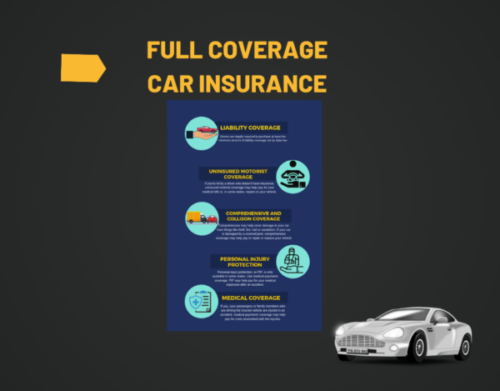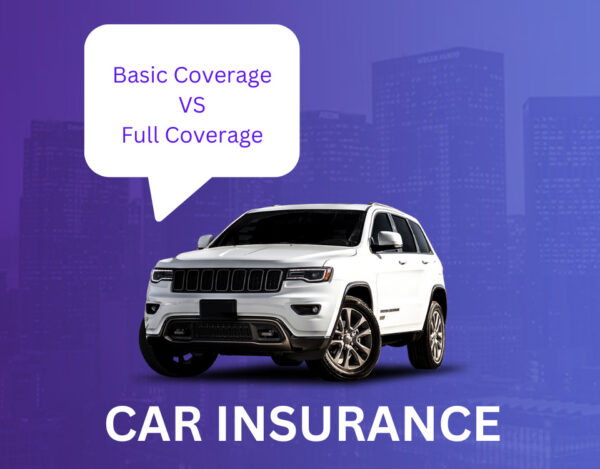what is the basic coverage vs full coverage

Liberty Mutual ends policies for businesses in 2023
July 28, 2023
Kia and Hyundai models not covered by insurance
July 31, 2023Table of Contents
ToggleWhat is the basic coverage vs full coverage? Making the Right Choice for You
what is the basic coverage vs full coverage?
Basic coverage (liability) meets legal requirements and only covers damage or injury you cause to others. Full coverage includes liability, collision, and comprehensive—covering your own car, theft, vandalism, weather damage, and medical bills. Full coverage offers broader protection but comes at a higher cost.
In the framework of insurance, “basic coverage” and “full coverage” refer to the level of protection provided by an insurance policy. These terms are commonly used in the motor insurance industry, but they can also apply to other types of insurance.
Basic Coverage:
It provides the essential protection that you need to drive legally. So, if you’re in an accident and you’re found to be at fault, basic coverage takes care of the other person’s injuries or property damage. However, when it comes to your vehicle repairs or your injuries, you’re on your own. Those costs won’t be covered under this basic plan.
Full Coverage:
Now, full coverage offers you a whole bunch of extra protection. By getting full coverage, you not only get the benefits of basic coverage, but you also get so much more! It’s like an all-inclusive package.
So, in addition to covering the other person’s injuries and property damage when you’re at fault, full coverage also has your back when things go wrong for you. Whether you accidentally crash into a wall or someone else crashes into you, your car repairs are taken care of. But that’s not all! Full coverage also comes to the rescue when your car gets stolen, damaged by a hailstorm, vandalized, or even if a runaway moose decides to ram into your vehicle.
Full coverage cares about your health too. If you or your passengers get hurt in an accident, the medical expenses are covered. And here’s the kicker: if you ever find yourself in an accident with someone who doesn’t have enough insurance or has no insurance at all, full coverage jumps in to save the day!
Full coverage comes with a high cost. It’s a bit more expensive than basic coverage because of all the extra protection it offers. Full coverage, on the other hand, is not a specific insurance type but rather a term used to describe a comprehensive insurance policy that includes various types of coverage beyond basic liability coverage.
What is Included in Basic Coverage?
Liability Coverage.
Basic coverage, also known as liability content. It provides protection against fleshly injury and property damage to a third person in an accident where you’re at fault. This means if you’re responsible for an accident, your insurance will cover the medical charges and property damage of the other party involved.
minimal Legal requirement
Basic coverage meets the minimum insurance conditions commanded by law in your particular governance. This ensures that you’re fairly allowed to drive or operate your vehicle.
What is not Included in Basic Coverage?
Your Own Vehicle Repairs
Basic coverage does not cover the cost of repairs to your own vehicle if you are involved in an accident, regardless of who is at fault. So, if your car gets damaged in a collision, you will have to pay for the repairs out of your own pocket.
Your Own Injuries
Basic coverage does not provide any coverage for your injuries or the injuries of your passengers. If you or your passengers are hurt in an accident, you will be responsible for your medical expenses.
Non-Collision Damage
Risks like damage to your car from events other than collisions, like theft, vandalism, natural disasters, or animal collisions, are not covered by a basic policy.
Uninsured/Underinsured Motorist Coverage
Basic coverage may not include protection if you are involved in an accident with a driver who has insufficient insurance or no insurance at all. For such scenarios, you would need additional coverage known as uninsured/underinsured motorist coverage.
In summary, basic coverage includes liability protection for injuries and property damage you may cause to others, and it fulfills the minimum legal requirements for driving. However, it does not cover your own vehicle repairs, your own injuries, damage from non-collision incidents, or provide coverage for accidents involving uninsured or underinsured motorists. For additional protection in these areas, you would need to consider purchasing additional coverage or upgrading to a full coverage insurance policy.
what is included in full coverage insurance?
Full coverage insurance commonly known as comprehensive insurance, is a more extensive insurance package that provides a wide range of protections. Specific details of full coverage can vary depending on the insurance company and policy, it typically includes the following components:

Liability Coverage
Similar to basic auto insurance coverage, full auto insurance coverage includes liability protection, which covers bodily injury and damage to the property of others that you cause in an accident when you have the blame.
Collision Coverage
Full coverage also includes collision coverage, which means your insurance company also pays for damages to your own car. This coverage helps you get your car back on the road without having to shoulder the entire financial burden of repairs.
Comprehensive Coverage
This is a crucial part of full coverage and provides protection for your vehicle against damage or loss resulting from non-collision incidents. It covers things like theft, vandalism, fire, hail, falling objects, and damage caused by animals. Basically, it safeguards your car from various unexpected events that can cause damage or loss.
Medical Payments Coverage
Comprehensive coverage also includes medical payments coverage, which helps pay medical bills for you and your passengers if you are injured in an accident, regardless of fault. This coverage can be especially helpful to cover immediate medical costs and co-pays.
Uninsured or Underinsured Driver Coverage:
With comprehensive coverage, you’ll have protection against uninsured or underinsured drivers. In the event of an accident involving an uninsured or underinsured driver, this component helps cover medical expenses and property damage.
It is important to note that although it is called “full coverage”, no insurance policy covers every possible scenario or expense. Policy limits and coverage details can vary, so it’s essential to read the policy documents carefully and understand what is and isn’t covered.
Although full coverage insurance offers more comprehensive protection than basic coverage, it comes with higher premiums due to the increased level of protection provided. However, for many drivers, the added peace of mind and benefits outweigh the higher cost, especially if they want better financial security in the event of unexpected incidents.
Is it better to get full coverage?
Whether you want full coverage or not depends on your situation and preferences. Comprehensive insurance typically includes both liability coverage (which pays for damage you cause to others) and comprehensive/collision coverage (which also pays for damage to your own vehicle).
Full coverage insurance provides more extensive protection and can be beneficial if you want greater peace of mind and protection for your vehicle in case of accidents, theft, or other incidents. It can be particularly helpful if you have a new or expensive car that you want to safeguard against potential financial losses.
However, full coverage insurance comes with higher premiums compared to liability-only coverage. If you are on a tight budget or have an older car with a lower value, you might consider whether the additional cost of full coverage is worth the benefits it offers.
Ultimately, it’s vital to evaluate your exact needs, financial condition, and risk acceptance when deciding on the right level of insurance coverage for you. You can also consult with insurance professionals to get tailored advice based on your conditions.
At what point is full coverage not worth it?
Full coverage may not be worth it in certain situations when the cost of the insurance premiums and other factors outweigh the benefits it provides. Here are some points to consider when determining if full coverage is not worth it:
The Value of Your Vehicle
If you have an older car with a low market value, the cost of full coverage premiums may be disproportionately high compared to the potential payout in the event of a claim. In such cases, it might be more sensible to opt for basic coverage or liability-only insurance.
High Deductibles
Full coverage policies often come with higher deductibles. If the deductible is too high and you cannot afford to pay it comfortably in the event of a claim, the coverage may not be practical for you.
Your Budget
If the cost of full coverage puts a significant strain on your budget or creates financial difficulties, you might need to reassess whether it is worth it. It’s crucial to choose coverage that fits within your financial means.
Age of Your Vehicle
As your vehicle ages, its value depreciates. At a certain point, the cost of full coverage premiums might not align with the car’s decreased value. Consider the potential payout versus the cost of insurance when making your decision.
Your Driving Record
If you have a history of safe driving and have not been involved in accidents, you might be at a lower risk of needing extensive coverage. In such cases, you could consider reducing your coverage to save on premiums.
Personal Risk Tolerance
Everyone has a different level of risk tolerance. Some people prefer to have maximum protection and are willing to pay higher premiums for that peace of mind. Others might feel comfortable with lower coverage and taking on more risk.
Availability of Alternative Funds
If you have a substantial emergency fund or savings set aside specifically for car repairs or replacements, you might feel more confident in opting for lower coverage.
Ultimately, the decision to forgo full coverage should be based on a careful assessment of your individual circumstances. Evaluate the factors mentioned above, consider your comfort level with risk, and make an informed decision that aligns with your financial situation and needs. It’s always a good idea to discuss your options with an insurance professional to find the right balance between protection and affordability.
Conclusion:
Full coverage car insurance is a comprehensive type of insurance that steps in to cover damage to your car, regardless of who caused the accident. While it comes with a higher price tag compared to basic coverage, it offers added peace of mind and might be required by your lender if you have a financed or leased car.
The decision to opt for full coverage depends on your unique situation and needs. If your car holds significant value or you want maximum protection, full coverage is worth considering. However, if you have the financial ability to cover repairs out of pocket, basic coverage might be sufficient. Keep in mind that with full coverage, you may also need to pay a deductible before the insurance kicks in. Weigh the pros and cons and choose the option that best fits your circumstances.
FAQ:
What is basic car insurance coverage?
Basic car insurance, also called liability insurance, covers injuries and property damage you cause to others. It doesn’t cover your own car.
What does full coverage include?
Full coverage includes liability, collision (for your own car damage), and comprehensive (for theft, fire, weather, etc.).
Is full coverage insurance worth it?
Full coverage is worth it for new or high-value cars or if you want maximum protection. For older cars, basic coverage may be enough.
When should I drop full coverage?
Consider dropping full coverage if your car’s value is very low, or if the cost of coverage is more than the car’s worth.
Does full coverage mean everything is covered?
No. Full coverage doesn’t cover everything. It doesn’t include mechanical failures, wear and tear, or some custom parts unless added.
What is the difference between full coverage and basic coverage?
Full coverage includes liability, collision, and comprehensive insurance, while basic coverage usually includes only liability insurance.
What is the meaning of basic coverage?
Basic coverage means liability insurance that covers damage or injuries you cause to others, not your own vehicle.
Why is full coverage better?
Full coverage protects both you and others—it pays for your car’s repairs in accidents, theft, or natural disasters.
What do you mean by full insurance?
Full insurance means having liability, collision, and comprehensive coverage to fully protect both you and your vehicle.




